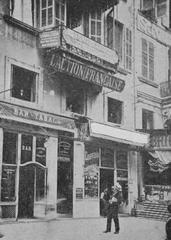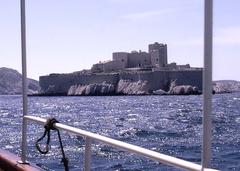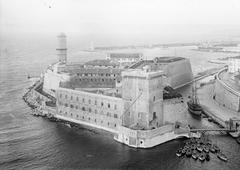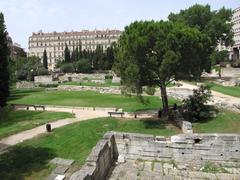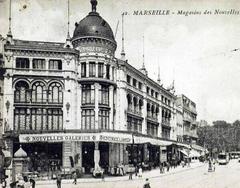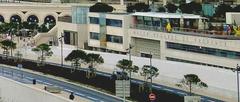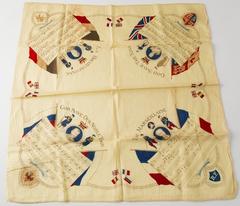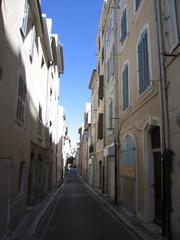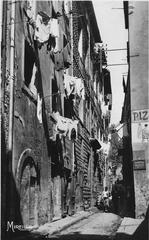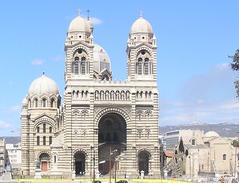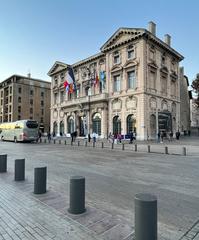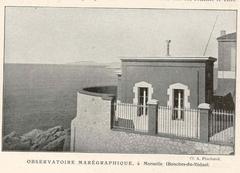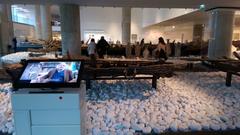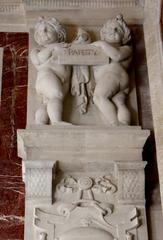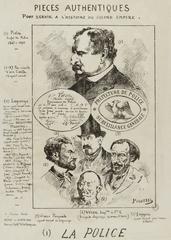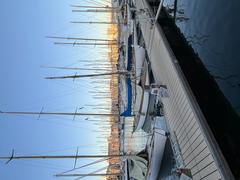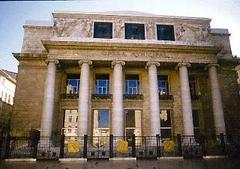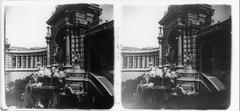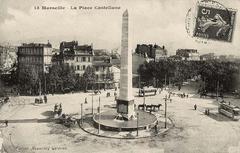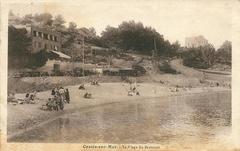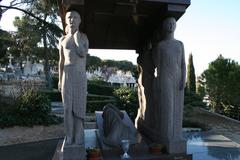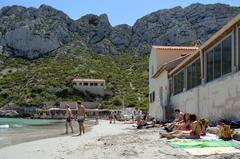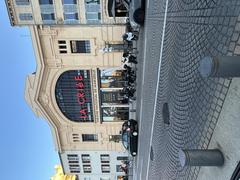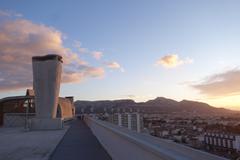
Les Riaux Visiting Hours, Tickets, and Guide to Marseille’s Hidden Historical Sites
Date: 04/07/2025
Introduction: The Significance of Les Riaux in Marseille
Nestled in the northern part of Marseille’s 16th arrondissement, Les Riaux stands as a testament to the city’s enduring maritime and industrial spirit. Far from the busy tourist centers, this distinct neighborhood offers an authentic window into Marseille’s working-class roots and multicultural evolution. Originally a rugged, rural coastline, Les Riaux transformed over centuries from medieval fishing hamlets into a thriving industrial hub, closely tied to the Grand Port Maritime de Marseille. The area’s strategic position along the Côte Bleue and proximity to transport corridors fostered the development of shipyards, factories, and worker housing, mirroring Marseille’s broader economic changes. Today, Les Riaux is characterized by early 20th-century architecture, the iconic Viaduc des Riaux, and lively street life, shaped by successive waves of Mediterranean migration.
Visitors to Les Riaux can enjoy panoramic coastal walks, bustling markets, and vibrant community events that highlight the neighborhood’s social cohesion and cultural diversity. While lacking grand monuments or traditional ticketed attractions, Les Riaux’s public spaces and scenic overlooks offer compelling experiences for those interested in Marseille’s lesser-known historical sites and traditions, such as pétanque. With easy access via public transport and proximity to the artistic enclave of L’Estaque, Les Riaux is ideal for travelers seeking an off-the-beaten-path immersion into Marseille’s maritime legacy and working-class culture. This detailed guide covers historical development, cultural highlights, visitor logistics—including accessibility, safety, and travel tips—to ensure a rewarding visit to this hidden gem (Marseille Heritage and Culture, MarseilleTourisme.fr, Wikipedia).
Table of Contents
- Introduction
- Historical Overview
- Industrial Growth and Urban Development
- Social and Cultural Evolution
- Architectural and Urban Heritage
- Notable Sites and Landmarks
- Visitor Information
- Practical Travel Tips
- Frequently Asked Questions (FAQ)
- Conclusion
- References
Historical Overview
Early Origins:
Les Riaux’s story is woven into the broader history of Marseille, one of France’s oldest cities, founded by Greek settlers in 600 BCE. While Les Riaux itself did not exist as a district in antiquity, its coastal location made it a natural site for fishing and agriculture as the city’s maritime economy expanded (Marseille Heritage and Culture). By the Middle Ages, the area featured small fishing hamlets, serving as both a resource and a protective buffer for the city.
Industrial Growth:
The 19th century brought rapid industrialization, transforming Les Riaux into a hub for shipyards, factories, and warehouses. Its proximity to the Grand Port Maritime de Marseille attracted workers and spurred the development of modest housing, communal facilities, and critical infrastructure like the Viaduc des Riaux and the nearby Tunnel du Rove (Carte de Marseille). These changes embedded Les Riaux deeply in Marseille’s maritime and industrial identity.
20th Century Evolution:
As traditional industries declined in the postwar era, Les Riaux faced challenges such as unemployment and urban decay. Despite this, the neighborhood’s resilience shone through, with strong community bonds and the arrival of new migrant populations from Italy, Spain, North Africa, and beyond, enriching the local culture (Wikipedia).
Social and Cultural Fabric
Community Life:
Les Riaux retains a village-like atmosphere, divided into micro-quartiers, each with its own identity (Wikipedia). Community events—like the annual “Jeux culturels et sportifs des Riaux”—foster a spirit of togetherness through music, sport, and cultural exhibitions (Mairie Marseille 15-16).
Multiculturalism:
The neighborhood’s proximity to the port has historically made it a gateway for newcomers, fostering a blend of languages, traditions, and cuisines (Nomadic Matt). This multicultural spirit is reflected in local markets, festivals, and everyday life.
Artistic Influence:
Part of the greater Estaque area, Les Riaux has inspired artists like Paul Cézanne, Georges Braque, and Raoul Dufy, who were drawn to its distinctive light and landscapes (Wikipedia). The neighborhood has also served as the backdrop for films depicting Marseille’s working-class resilience (Provence 7).
Architectural and Urban Heritage
Les Riaux’s urban landscape features early 20th-century housing blocks, fishermen’s cottages, and remnants of industrial architecture. The narrow, winding streets and terraced houses reflect adaptation to the rugged coastal terrain. Recent efforts at urban renewal focus on preserving this character while improving public spaces and amenities (POP Culture).
Notable Historical Sites and Landmarks
- Viaduc des Riaux:
A striking railway viaduct offering panoramic views of the Mediterranean and Marseille’s industrial port. It is a favorite site for photographers, especially at sunset (Inventaire PACA). - Chapelle La Galline:
An important spiritual landmark for locals (Provence 7). - Grand Port Maritime de Marseille:
One of the Mediterranean’s largest ports, accessible from the neighborhood and integral to its identity (MarseilleTourisme.fr). - Traditional Markets and Bakeries:
Experience authentic local flavors and community life in the neighborhood’s modest commercial centers.
Visitor Information
Neighborhood Tours
Guided walking tours focusing on Les Riaux’s industrial heritage and community life are offered seasonally. Check with Marseille’s tourism offices or local organizations for schedules.
Visiting Hours and Tickets
Les Riaux is a residential neighborhood with no official visiting hours or entrance fees. Most sites and public spaces are accessible year-round and at any time, though guided tours and local markets operate on set days. The Viaduc des Riaux and other landmarks are freely accessible.
Accessibility
Les Riaux is served by bus lines and is near L’Estaque train station, with regional TER train services providing access from central Marseille. Note that the terrain is hilly and some streets are narrow and uneven, which may pose challenges for visitors with mobility impairments.
Nearby Attractions
- L’Estaque:
Renowned for its artistic heritage and vibrant Sunday markets. - Marseille’s Old Port and Le Panier:
Easily accessible by public transport for a broader city experience. - Calanques de la Côte Bleue:
Scenic cliffs and coves ideal for hiking and nature walks.
Photography Spots
The Viaduc des Riaux and coastal viewpoints offer excellent opportunities for panoramic shots, particularly during sunset.
Practical Travel Tips
- Best time to visit: Spring and early autumn offer pleasant weather and vibrant local life.
- Footwear: Wear sturdy shoes for walking along hilly and uneven streets.
- Safety: The neighborhood is generally safe during the day; exercise standard precautions at night and avoid isolated areas (Following the Rivera).
- Amenities: Shops, eateries, and ATMs are limited in Les Riaux; more options are available in nearby L’Estaque.
- Language: French is predominant; basic English may be spoken in tourist-oriented areas. Greeting locals with “Bonjour” is appreciated.
- Public Transport: An RTM day pass is convenient for exploring Marseille’s neighborhoods.
Frequently Asked Questions (FAQ)
Q: Are there entrance fees to visit Les Riaux or the Viaduc des Riaux?
A: No. The neighborhood and its sites are freely accessible, with no ticketed entry required.
Q: How do I get to Les Riaux from Marseille city center?
A: Take RTM bus lines toward L’Estaque or regional TER trains to L’Estaque station, then walk or transfer to a local bus.
Q: Is Les Riaux suitable for families?
A: Yes, with parks, coastal walks, and community events making it family-friendly.
Q: Where can I eat or shop in Les Riaux?
A: Options are limited; visit L’Estaque for a greater variety of markets, bakeries, and restaurants.
Q: Are there hotels in Les Riaux?
A: Accommodation is limited; most visitors stay in L’Estaque or central Marseille (Pariseater).
Conclusion
Les Riaux offers a rewarding journey for travelers seeking Marseille’s authentic spirit—beyond the city’s iconic monuments. This neighborhood embodies the resilience of working-class communities, the richness of Mediterranean migration, and the enduring connection to the sea and industry. With its scenic paths, historical landmarks like the Viaduc des Riaux, and vibrant community events, Les Riaux invites visitors to engage deeply with the city’s diverse heritage. Plan your visit during the mild seasons, respect the residential character, and support local businesses to preserve the neighborhood’s unique identity.
For more information, download the Audiala app for self-guided tours, consult Marseille’s official tourism resources, and explore related articles for insider tips.
References
- Marseille Heritage and Culture
- MarseilleTourisme.fr
- Wikipedia
- Provence 7
- Inventaire PACA
- Carte de Marseille
- POP Culture
- Mairie Marseille 15-16
- Nomadic Matt
- Following the Rivera
- Pariseater
- France Voyage
- All Events in Marseille
- Marseille Secrète

